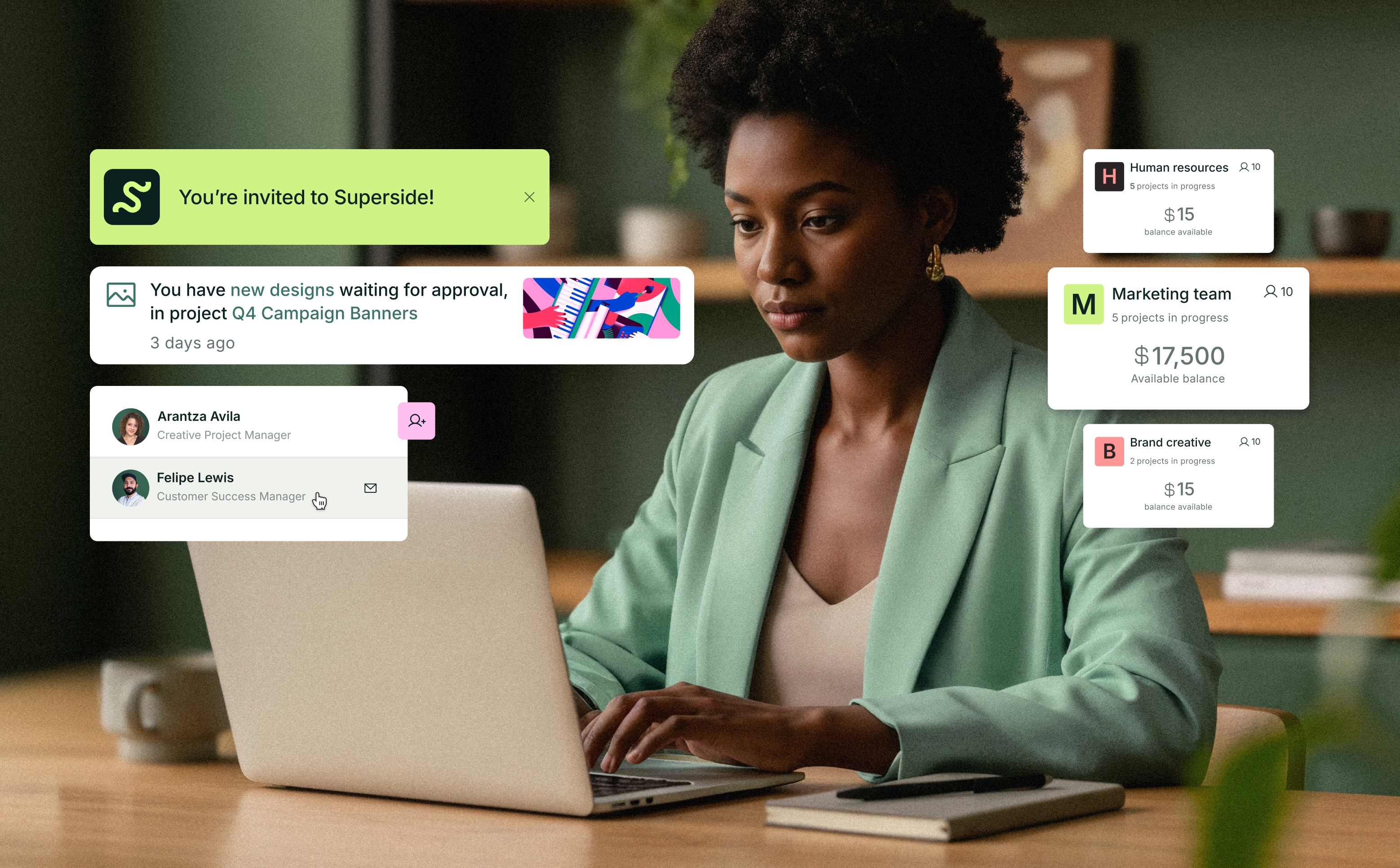
Designing without a strategy is like painting without a sketch—how do you know where to start without an outline of the final result?
Even if you have a clear idea of what you want to create, a design strategy ensures the entire team starts and ends each project in the right place—without 7 back-and-forth revisions along the way.
There's a lot to keep in mind when creating designs for a company, including brand guidelines, target audience, distribution channels, and more.
A design strategy organizes all this information to align with the overall goals and objectives of the business. After all, most companies can’t afford design for the sake of designing—it must serve the business.
Wherever you are in your design process, here’s an outline of the topic (or a sketch, if you will) that walks through how to create a design strategy for your next project and examples of design strategy applied in different contexts.
Outline✏️
- What is Design Strategy?
- How to Create a Design Strategy for Your Next Project
- Strategic Design Thinking Applied: Examples and Templates
- The Role of DesignOps in Design Strategy
What is a Design Strategy?
Design strategy is the combination of profitability, corporate strategy, and meeting user needs.
A design strategy guides how design teams work to meet business objectives through design. Creative teams refer to this strategy throughout the design process, ensuring that each creative asset or concept actually makes sense for the project.
A design strategy ensures that every asset is created with the business goals and objectives in mind. It works as a bridge between those things, prioritizing tasks and design requests.
— Piotr Smietana, Marketing Creative Director at Superside
Let’s walk through a scenario we've all likely experienced:
Your company is building out a new homepage design. The marketing team knows what they need, so they ship the copy over to a UI/UX designer to get started. However, with no strategic design process in place, the final build loads slowly, which hurts SEO, and doesn’t improve lead generation as the marketing team intended. The design process has to start over.
With a documented strategy in place, you avoid wasting precious time. The designer gets a starting point, including the context for the homepage update, its functions and intended goals.
This lesson illustrates why design strategy is important:
- It saves time by helping teams execute in the correct direction
- It saves money by mobilizing design resources efficiently
- It gives designers direction informed by other stakeholders
- It accomplishes business goals by tying design to outcomes
To further cement that last point, we look to McKinsey’s Design Index (MDI) and their study on the business value of design. Top MDI performers (companies who scored high on the MDI scale) saw increased revenue and total returns to shareholders.
How to Create a Design Strategy for Your Next Project
The next time you start working on a major design project, give yourself enough time to create a documented, comprehensive design strategy that helps provide a roadmap for each phase of the project.
Not sure where to start with creating your design strategy? Follow these five steps:
- Set business goals for the project
- Research the market
- Set your brand identity
- Create a standardized project brief
- Design and test
1. Set business goals for the project
Your design strategy should achieve business outcomes defined by the needs of your company and its users.
These goals are detailed, such as business growth objectives like increasing top-line revenue by 50% in 12 months, or increasing blog conversions by 5% over the next quarter.
Here’s where you want to run a design sprint workshop to help define the main business problems and gain valuable insights that contribute to your strategy.
Bring in as many stakeholders as possible, and gather as much information as you can before committing.
— Devon Fata, CEO of Pixoul
Summarize the details of your strategy to achieve these goals, which should be clear, measurable, and specific to different roles. Lay out what KPIs you’ll measure to define what success looks like. Then let stakeholders weigh in again to align on expectations.
2. Research the market
Every good strategy requires extensive research. While it’s never a bad idea to be on the cutting edge of your industry, understanding what already works for competitors can be a great starting point.
In the research phase of your design strategy, look into:
- Your target audience
- What is working for the competition
- Design concepts you like
- Design concepts you want to avoid
- Color psychology compared to your goals
You need to know who and what the design is for. This will help you determine things like your color palette and the kind of design style you want to use.
— Alejandra Mariscalez, a lead designer at Visme
Mariscalez continues: “Is it for a younger audience or older? Does your design need to be simple and to the point? Or does it need to offer more information? This will help you create a relevant design that is more focused on your target audience and fulfills its function.”
Your company is likely founded on a competitive advantage—something that sets you apart from the flock. To find a competitive edge in design strategy, look for something that your competitors cannot replicate.
Turn their weakness into your strength.
Take the Shopify blog, for example. The company works with illustrators and designers to create custom hero images for its high-value blog posts.
Shopify’s hero images are colorful, attractive, and different from competing posts. Many organizations in the software industry use stock images that can be found anywhere online, like our example below.
Shopify found a design weakness in the industry and doubled down.
But you can run into other unanticipated problems if you execute without a design strategy, such as trying to build your brand through content marketing but using stock photography throughout your blog.
What does it say to the audience? A design strategy can help you uncover a fast, cost-effective way to produce custom on-brand blog header image that can be your differentiator.
After reviewing your design research, your place within market trends, your business objectives, and your competitors’ strengths and weaknesses—you can now identify a design strategy that separates your brand from the competition: your brand identity.
3. Set your brand identity
Online competition has given consumers infinite choices. Brands look for ways to emotionally connect with customers—becoming memorable and forming long-term relationships.
A strong brand identity stands out in a crowded marketplace, it appeals to the senses through its design. People see it, hear it, and feel it. It reinforces the emotions of your brand, no matter what asset you’re designing.
Elements of brand identity design include:
- A memorable logo that embodies your positioning.
- A visual language that makes you recognizable. Think color palette, scale, proportion, typography, and motion of your design.
- A feel, which is more sensory, emotional, and experiential.
- On-brand imagery with a consistent style and focus.
Design is intelligence made visible.
— Alina Wheeler, author of Designing Brand Identity
Once you have the core elements of your identity, create brand guidelines in a style guide.
The style guide provides clear direction on how to use your colors, typography, and design assets across all marketing materials: emails, social media posts, blogs, ads, etc.
Create a hub where your style guide lives so anyone can download the logo, image files, hex codes, and other branded assets.
4. Create a standardized project brief
The next step is putting together a design brief. This is a critical part of your strategy because it guides every design project in your company.
A good design brief should include the following:
- Project scope: A brief overview of the project, including the time allotted, resources needed, and budget.
- Target audience: An outline of the customer persona(s) that are being targeted with this design.
- Assignee(s): The task owners and stakeholders for the project.
- Roadmap: An estimate of the project start date, timeline, and major milestones.
- Deadline: A timeline for feedback and final deadline dates.
- Deliverables: The specific assets that need to be provided by the final deadline.
- Available assets: The logos, illustrations, fonts, colors, and other branding assets designer(s) can use for work.
To help you create a design brief for your strategy, take advantage of this free design brief template we’ve created for you:

5. Design and test
Once you’ve finished the first four steps, you’re ready to submit and circulate the design strategy to the design team members working on the project (depending on your design team structure, they may have played an integral role in developing the strategy).
The first iteration of your design strategy might not be the final version. And that’s okay. It’s a common challenge many designers face when setting a design strategy.
I like to keep it simple in the early days. Build and iterate [on your strategy]. Don’t be afraid to make large-scale design changes frequently, as long as they’re underpinned with the right product and business strategy.
— Brian Casel, Lead Designer and founder of ZipMessage
Through Casel’s experience, he’s learned that you never really know if your design strategy works until it’s in the hands of users, citing the importance of post-launch interaction.
This is why you need to deploy the strategy, have your team adhere to it, then request feedback on the process. Adjust accordingly each time.
Even after you’ve nailed your design strategy, regularly reviewing designer feedback about the process is vital to ensuring your team is always performing and engaged.
Examples of Strategic Design Thinking Applied (And Templates to Steal)
Now that you know how to create your own design strategy, let’s look at a few real-life applications, especially keeping overall business goals in mind.
Understand that many design strategies will need to involve a number of different teams (e.g. marketing, sales, HR).
How to use design strategy to optimize landing page designs
Healthmine used Superside to speed up its landing page redesigns as part of a new website launch project.
When creating a landing page design, you’ll want to involve your sales, content, design, and development teams.
Start with the sales and content teams working together on a brief detailing each feature, benefit, and advantage of the product or service the landing page needs to include.
Next, the content team writes the copy and ships it off to the design team.
From here, it’s time for DesignOps or the project manager to put together the landing page design strategy.
The design strategy for landing pages should include:
- The target audience of the page such as personas, use cases, and demographics.
- The goals this page should achieve such as book a demo, buy a product, generate web traffic for ad revenue
- Any comparable industry pages, including what works, what do you like, what you can repurpose for your own
- The written copy for the landing page with indications for headings and formatting
- The assets or branding guidelines to offer a starting point or guardrails for the project
- The designer(s) assigned to the task, including who is responsible for what
- The overall project deadline, including timelines and work-back schedules to keep designers on task
Graphic Designers and UX/UI designers will likely take the reins for this project, creating the visual assets on the page and the overall page design. The goal is to ensure it provides the best customer experience in order to generate more traffic and conversions.
Once the design has been created and approved, it’s then sent to the developer to create and launch.
Project complete.
How to use design strategy for ad creative in conversion-focused campaigns
Curology produce a high volume of creative variations for social media ads using Superside.
Another example of design strategy in action is when a marketing team needs to launch a new ad campaign. They need to design the ad creative before the campaign can go live.
Before designing anything, step one is to define the ad objectives and distribution channels because designs for Facebook audiences will likely be different than LinkedIn audiences.
The ad creative design strategy should include:
- The type of ad and required image dimensions (e.g. a carousel ad for Instagram, or a video ad on LinkedIn)
- The ad objectives to hit the marketing team’s goals
- The product or service the ad is promoting
- The written copy and brand assets to incorporate into the design
- The designer(s) assigned to the task
- The number of iterations required to run A/B tests on ad variations
- The overall project deadline, including campaign start/end date
The designer can then share the ad creative with the marketing team who can launch the ad campaign and track its performance.
Your ad creative design strategy may also include an additional time frame to test new concepts based on ad performance (i.e. ad fatigue).
How to use design strategy in a big business decision like a rebrand
A rebrand unveiling video for Meta (formerly Facebook)
Our last design strategy example is for a rebrand. According to Entrepreneur.com, on average, brands change their corporate identities every 7 to 10 years.
When your company is ready, start the conversation by understanding what isn’t working (e.g. brand name no longer represents the company, poor reputation, too similar to another company) and why you’re looking to rebrand (e.g. encompassing the company's current ethos, repositioning for a new audience, updating our image, etc.).
The design strategy for a rebrand should include:
- Your customer personas. Perform updates and tweaks based on changes to your target audience.
- Your color psychology research. Reanalyze your brand colors. for example, yellow means clarity and warmth, whereas red is for passion and energy
- Your goals for the rebrand. Decide whether you’re trying to change customer’s perceptions, modernize the brand, or adapt to customers’ changing needs and tastes.
- A list of competitor logos. review their commonalities, and how your brand can stand apart.
- The amount of collateral damage. A rebrand likely means a change to packaging, store signage, and billboards (to name a few). Think of all the places your brand connects with your audience and the legwork needed to change it all, from sizes to materials to installers.
- A rebrand brief. A detailed document that includes the vision, mission, promise, and values.
- The designer(s) assigned to the task. Who is working on what?
- The overall project deadline. Timelines and work-back schedules to keep everyone on target.
With something as complex as a rebrand, this strategy will likely be expansive to ensure it hits the nail on the head. Nearly every team should be involved in making this design project a success.
The Role of DesignOps in Design Strategy
With proof that revenue increases with good design, and knowledge of how good design gets better with a design strategy, the next phase of growth is DesignOps or design operations—where design gets woven into the fabric of the business.
Having a DesignOps team or manager can change the way your company views design, streamlining processes and showing executives that a designer's input is essential at each step of the design process.
This role helps design teams become more involved in conversations with other departments, ensuring their voice is heard as part of the strategic planning process.
As Tim Brown, CEO of IDEO, says: “Thinking like a designer can transform the way you develop products, services, processes—and even strategy.”
DesignOps resolves important issues like communication within the design team and with other departments, building a positive team culture, onboarding new designers, and managing large-scale projects.
Think about the role of operations in a business. They oversee business functions, improve processes, and ensure the business runs smoothly.
DesignOps works the same way—except they focus specifically on the design team.
Their goal is to ensure designers on their team have the proper communication processes, tools, and strategies in place for success. Having DesignOps oversee your design team streamlines the design process and creates consistency in output.
Now, we can talk about the benefits of DesignOps a million times over, but it’s better to show you metrics based on real-life implementations.
By adding a single design project manager to their design team of 14, Intuit was able to increase their design output by 70 hours per week, taking their weekly time spent designing from 37% to 50%.
Although you might not realize it, your business needs design. From your website and your branding to your social media presence and your internal documents, design is involved in nearly every business process.
But without a design strategist or operations manager, your design team could become disorganized, wasting time on emails, meetings, project planning, and other tasks that simply aren’t what we'd call "designing."
Develop a Design Strategy Before You Start
A design strategy is just as important as a business strategy or marketing strategy—meaning you shouldn’t start any major design, whether an ad, landing page or sales presentation without one.
Getting aligned before you begin ensures your design projects end up where they should: moving the needle for your business.












